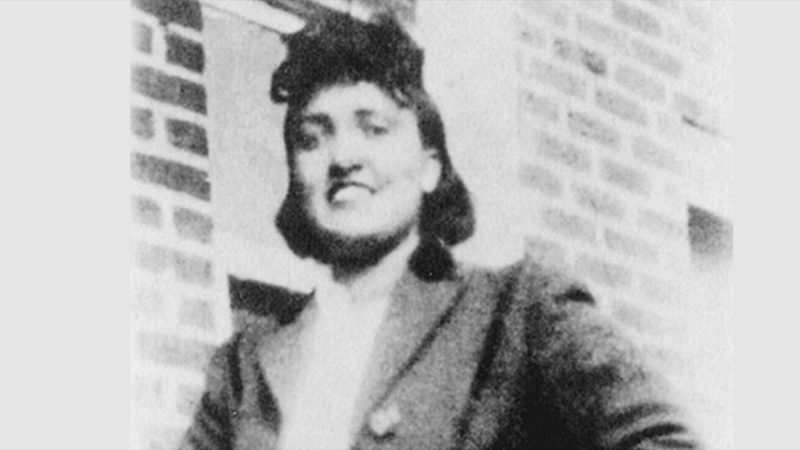Johns Hopkins University, Johns Hopkins Medicine and Family of Henrietta Lacks Announce Plans to Name a Research Building in Honor of Henrietta Lacks
10/06/2018

Surrounded by descendants of Lacks, Daniels and Rothman made the announcement at the 9th annual Henrietta Lacks Memorial Lecture in the Turner Auditorium in East Baltimore.
“Through her life and her immortal cells, Henrietta Lacks made an immeasurable impact on science and medicine that has touched countless lives around the world,” Daniels said. “This building will stand as a testament to her transformative impact on scientific discovery and the ethics that must undergird its pursuit. We at Johns Hopkins are profoundly grateful to the Lacks family for their partnership as we continue to learn from Mrs. Lacks’ life and to honor her enduring legacy.”
Henrietta Lacks’ contributions to science were not widely known until the 2010 release of the book The Immortal Life of Henrietta Lacks by Rebecca Skloot, which explored Lacks’ life story, her impact on medical science and important bioethical issues. In 2017, HBO and Harpo Studios released a movie based on the book, with Oprah Winfrey starring as Deborah Lacks, Henrietta Lacks’ daughter.
Several Lacks family members attended today’s event. “It is a proud day for the Lacks family. We have been working with Hopkins for many years now on events and projects that honor our grandmother,” said Jeri Lacks, granddaughter of Henrietta Lacks. “They are all meaningful, but this is the ultimate honor, one befitting of her role in advancing modern medicine.”
“In addition to changing the course of modern medicine with the impact of HeLa cells, we have learned many important lessons from Henrietta Lacks’ experience. We have a responsibility to our patients, in the care we deliver as well as when we partner with patients to pursue important scientific questions,” Rothman said. “As we honor Mrs. Lacks and her family, we will take a thoughtful approach to the design of the building so that it conveys our commitment to developing trust with our patients, their families and our community.”
The building, which will adjoin the Berman Institute of Bioethics’ Deering Hall, is located at the corner of Ashland Ave. and Rutland Ave., north of The Johns Hopkins Hospital and in the heart of the Eager Park community. The building will support programs that enhance participation and partnership with members of the community in research that can benefit the community, as well as extend the opportunities to further study and promote research ethics and community engagement in research through an expansion of the Berman Institute and its work.
The story portrayed in The Immortal Life of Henrietta Lacks points to several important bioethical issues, including informed consent, medical records privacy, and communication with tissue donors and research participants.
“The story of Henrietta Lacks has encouraged us all to examine, discuss and wrestle with difficult issues that are at the foundation of the ethics of research, and must inform our relationships with the individuals and communities that are part of that research,” said Jeffrey Kahn, director of the Johns Hopkins University Berman Institute of Bioethics. “As a result, students, faculty and the entire research community at Johns Hopkins and around the world do their work with a greater sensitivity to these critical issues.”
First discovered when Lacks was a patient at Johns Hopkins in 1951, the HeLa cells are a remarkably durable and prolific line of cells developed by Johns Hopkins researcher George Gey during Henrietta Lacks’ treatment for cancer.
A sample of Lacks’ cancer cells was retrieved during a biopsy and sent to Gey's nearby tissue lab, where he had been collecting cells from patients who came to The Johns Hopkins Hospital with cervical cancer. He discovered Lacks’ cells were unlike any of the others he had seen: Where other cells would die, Lacks' cells survived, and the number of cells would double every 20 to 24 hours. Soon after that, he began sharing the cells, at no cost, with researchers around the world.
Although many other cell lines are in use today, over the past several decades, the HeLa cell line has contributed to many medical breakthroughs — from the development of the polio vaccine, to the study of leukemia and other cancers, the AIDS virus, and even the effects of zero gravity in outer space.
In 2013, Johns Hopkins worked with members of the Lacks family and the National Institutes of Health (NIH) to help broker an agreement that requires scientists to receive permission to use Henrietta Lacks’ genetic blueprint in NIH-funded research.
The NIH committee tasked with overseeing the use of HeLa cells now includes two members of the Lacks family. The medical research community has also made significant strides in improving research practices, in part thanks to the lessons learned from Henrietta Lacks’ story.
“It has been an honor for me to work with the Lacks family on how we can recognize the contribution of Henrietta Lacks to medical research and the community. Their willingness to focus on the positive impact of the HeLa cells has been inspiring to me. The Henrietta Lacks story has led many researchers to rededicate themselves to working more closely with patients,” said Daniel E. Ford, vice dean for clinical investigation in the school of medicine. “The new building will be a hub for the community engagement and collaboration program of the NIH-supported Institute for Clinical and Translational Research.”
Johns Hopkins’ work with members of the Lacks family since 2010 has resulted in the development of a series of programs to recognize and honor Henrietta Lacks and her extraordinary contribution to clinical research and the advancement of health throughout the world.
Groundbreaking on the building that will be named for Henrietta Lacks is scheduled for 2020 with an anticipated completion in 2022.
To learn more about Henrietta Lacks and the wide-ranging impact of HeLa cells on medical research, please visit: www.hopkinsmedicine.org/henriettalacks.
